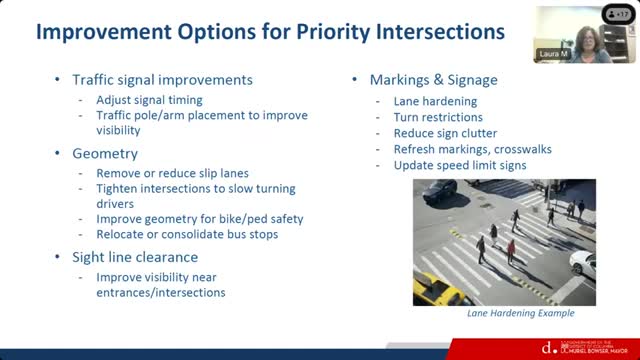Traffic Safety Overhaul Planned for Challenging Intersections
November 01, 2024 | Department of Transportation, Agencies, Organizations, Executive, District of Columbia
This article was created by AI summarizing key points discussed. AI makes mistakes, so for full details and context, please refer to the video of the full meeting. Please report any errors so we can fix them. Report an error »

In a recent government meeting, officials outlined a series of proposed improvements aimed at enhancing pedestrian safety and traffic flow at various intersections. Key discussions focused on modifications to signal timing and phasing, particularly concerning pedestrian crossings. The team is considering relocating poles, improving visibility, and making geometry adjustments at locations identified as safety challenges. These adjustments may include narrowing slip lanes and tightening turning radii to slow down vehicles.
The meeting highlighted plans for curb extensions on side streets, although such changes will not be implemented on Connecticut Avenue due to its six-lane configuration. Additionally, officials are exploring the consolidation or relocation of bus stops to improve visibility for pedestrians and cyclists.
A thorough review of signage is also underway, with the goal of reducing clutter and enhancing clarity. This includes potential restrictions on turn lanes and the introduction of lane hardening measures to encourage slower travel speeds.
The discussion also addressed \"uncivilized intersections\" along the corridor, where data collection has indicated the need for a full traffic signal at Chesapeake and a HAWK signal at another location to facilitate safer pedestrian crossings. Other intersections that did not meet the criteria for signalization will still receive attention through improved signage and visibility measures.
Looking ahead, the project scope has shifted due to budget constraints, prompting a transition to smaller-scale improvements. Community outreach will be a critical component of the process, allowing residents and advisory neighborhood commissions to provide input on proposed changes. The timeline for design and implementation is expected to span over 12 months, with further updates anticipated as the project progresses.
The meeting highlighted plans for curb extensions on side streets, although such changes will not be implemented on Connecticut Avenue due to its six-lane configuration. Additionally, officials are exploring the consolidation or relocation of bus stops to improve visibility for pedestrians and cyclists.
A thorough review of signage is also underway, with the goal of reducing clutter and enhancing clarity. This includes potential restrictions on turn lanes and the introduction of lane hardening measures to encourage slower travel speeds.
The discussion also addressed \"uncivilized intersections\" along the corridor, where data collection has indicated the need for a full traffic signal at Chesapeake and a HAWK signal at another location to facilitate safer pedestrian crossings. Other intersections that did not meet the criteria for signalization will still receive attention through improved signage and visibility measures.
Looking ahead, the project scope has shifted due to budget constraints, prompting a transition to smaller-scale improvements. Community outreach will be a critical component of the process, allowing residents and advisory neighborhood commissions to provide input on proposed changes. The timeline for design and implementation is expected to span over 12 months, with further updates anticipated as the project progresses.
View full meeting
This article is based on a recent meeting—watch the full video and explore the complete transcript for deeper insights into the discussion.
View full meeting